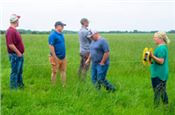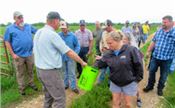A Grazing School Lesson
ELDON COLE
MT. VERNON, MO.
Since the early 90’s, Missouri Grazing Schools have been a popular class all across the state. Most of the schools are two or three days in length. Besides learning a lot about grazing, fencing, water needs and pasture fertility, attendees may qualify for cost-share dollars.
During the last week of May a grazing school was held at the University of Missouri Southwest Research Center, Mt. Vernon. The Center is well-equipped to host the event and a part of the school is an exercise in pasture allocation. The class is divided into three groups and each is given power fencing equipment, an area of fescue pasture along with five, 650-pound steers. The charge is to decide how much pasture area their steers need for the next 24 hours.
Their “pasture” has water available and can be as big or small as the group wants. In addition, at this school we ask the class to grab a handful of “pasture” they felt would represent what a grazing animal would consider very tasty and nutritious. We collected those bites and took them to Custom Laboratory at Monett for a routine forage analysis.
The material placed in the collecting bucket was mostly fescue including seed heads, some clovers, cheat and random weeds were also included. The last day of the school, the test results were shared with the group. Here is the Lab’s analysis.
The test revealed the forage sample was very high in moisture, 81 percent which wasn’t a big surprise. The 650 lb. steers if gaining 2 pounds per day have a daily dry matter requirement of about 14.4 pounds. Thus, the steers need to eat 75 to 80 pounds of the actual green material each day to meet their needs.
The 16 percent protein forage is more than adequate to support over two pounds per day gain. The TDN level, however is a bit short of hitting the mark of 68 percent to make two pounds a day gain if the classes’ cattle bites were truly representative of what the steers choose.
As a rule, cattle probably graze a little bit higher quality green material than our students did. Thus, the steers TDN needs for two pounds a day gain were very close. A growth promoting implant and an ionophore-containing supplement each day should enable the steers to attain the target of at least two pounds per day gain.
Grazing schools introduce attendees to many grazing concepts and instructors they can use to be successful and profitable. Contact your nearest University of Missouri Extension field specialist for details on a grazing school near you. ∆
ELDON COLE: Extension Livestock Specialist, University of Missouri
Dry matter 18.7%
Crude protein 16.2%
Acid detergent fiber 32.4%
Neutral detergent fiber 51.3%
Total Digestible Nutrients 61.2%
Net energy-lactation 61.9 MCAL/lb.
Relative Feed Value 115
Nitrate Negative

Students debate how much space is needed for their five steers for 24 hours.

Students bring their cattle bites to the selection bucket, held by Tim Schnakenberg, Extension Agronomy Specialist.
Photos supplied